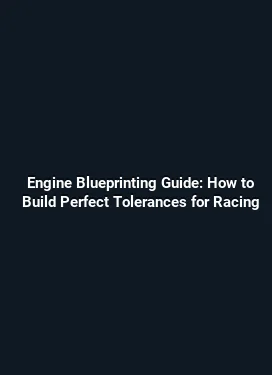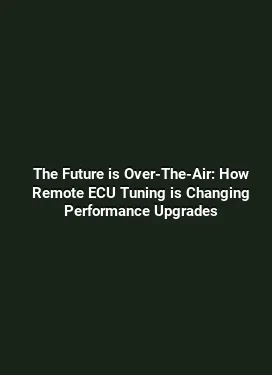Unlocking Hidden Power: A Deep Dive into Stage 1 ECU Remapping and Safe Limits
Stage 1 remapping represents one of the most accessible avenues for unlocking additional performance from a stock engine without sacrificing daily drivability. This article provides a detailed, data-driven look at how Stage 1 adjustments are typically implemented, what to expect in terms of power and driveability, and the practical considerations that accompany tuning a modern engine. Readers will gain actionable insights into fuel delivery, ignition timing, load-based mapping, and the diagnostic tools that help ensure safe operation.
Understanding the Core Concepts Behind Stage 1 Mapping

At the heart of Stage 1 tuning lies a careful adjustment of the engine’s fueling and timing to extract more usable power while maintaining reliability. Unlike more aggressive stages, Stage 1 focuses on keeping essential components—sensors, actuators, and stock hardware—within their designed operating windows. The objective is to improve throttle response and mid-range torque without introducing harsh idle behavior or drivability issues on a daily basis.
Key components of the tuning process include mapping the fuel delivery to match the engine’s air intake at various RPM and load conditions, and fine-tuning ignition timing to maximize efficiency and prevent detonation. Modern engines rely on rapid feedback from multiple sensors; the remapping process leverages these feedback loops to optimize performance while preserving exhaust emissions compliance and catalytic efficiency. It is important to recognize that even modest gains require careful validation on a dyno or road-based testing to confirm that the engine remains within safe operating margins.
How Fuel Mapping Shapes Power and Response

Fuel mapping, or how the ECU commands fuel injectors, is the primary driver of performance improvements in Stage 1 tunes. By leveraging precise injector pulse widths and high-octane-safe fueling strategies, tuners can reduce optional lean conditions at high loads and maintain stable air-fuel ratios during rapid throttle swings. A well-executed map avoids over-rich mixtures that can waste fuel and under-rich conditions that threaten piston integrity. Beyond raw lambda targets, the distribution of fueling across RPM bands influences mid-range torque heavily, where daily driving typically spends the most time.
Practically, you should expect smoother acceleration curves and a more linear throttle response as the engine breathes more efficiently. The tuning process also accounts for transient events such as gear shifts or sudden throttle inputs, ensuring the air-fuel mix adapts rapidly without producing large instantaneous deviations that could upset engine stability.
Ignition Timing: Crafting a Safe Yet Aggressive Spark Curve
Ignition timing adjustments are a delicate balance between extracting more energy from the air-fuel mix and avoiding premature detonation. In many engines, Stage 1 remapping shifts timing slightly toward the advanced side at moderate boost and RPM ranges, which can improve peak power and throttle response. However, the exact degree of timing adjustment depends on the engine family, compression ratio, knock resistance, and fuel quality available to the user.
Implementing a robust timing strategy requires monitoring knock events and ensuring that the engine’s knock sensor feedback loop remains reliable. A prudent Stage 1 approach keeps timing within a safe corridor, often stepping up timing in progressive steps and testing under controlled conditions. This measured approach helps preserve engine life while delivering the promised performance gains. An often overlooked aspect is the interaction between timing and fueling; advancing timing on a rich map versus a lean map can yield very different outcomes, underscoring the need for coordinated calibration across multiple map cells.
Managing Detonation Risk Through Real-World Testing
Detonation is the enemy of reliability. Stage 1 tuning mitigates this risk by using conservative timing shifts, calibrated fuel strategies, and robust diagnostics. Some vehicles benefit from brief, low-load correction during cold starts or in ambient conditions where fuel quality may vary. The inclusion of a safety buffer in the map can prevent knock events during aggressive driving, particularly in high-load scenarios like spirited mountain ascents or rapid overtakes on highways.
Practically, a tuner may rely on data logging to compare engine states across time and temperature ranges. By reviewing trends in knock counts, air-fuel ratios, and timing advance, the tuner can refine the map to hold steady performance without crossing critical thresholds. This iterative approach is central to building a map that feels strong in the mid-range while remaining dependable in daily use.
Dynamometer and Road Testing: Verifying Real-World Performance
Power figures told by a dyno can be seductive, but the true value of Stage 1 tuning lies in consistent, repeatable performance under real-world conditions. A professional test session typically includes multiple runs across a controlled temperature window, followed by road validation that mirrors common driving patterns. This combination helps verify that the gains translate from the bench to the street without compromising reliability or drivability.
During dyno testing, practitioners focus on torque delivery across the RPM spectrum, not merely peak horsepower. A well-tuned Stage 1 map should widen the torque band, making low- to mid-range power more accessible in everyday driving. Additionally, exhaust gas temperature (EGT) trends, fuel trim stability, and sensor feedback are monitored to ensure the tune remains within safe boundaries. Road testing then confirms that throttle response remains linear, shift points are reasonable, and there is no unwanted surging or stalling in typical traffic conditions.
Practical Considerations for Daily Driving
Daily drivability is a core measure of success for Stage 1 tunes. Drivers expect a noticeable improvement in response without the burden of rough idling, unfamiliar surges, or instability during winter starts. The chosen map should preserve fuel economy characteristics within a reasonable range, particularly on commuter trips. A robust tune also accommodates minor variations in fuel quality, ambient temperature, and altitude by leveraging adaptive learning in the ECU without sacrificing core objectives.
Owners should consider maintenance implications, such as ensuring the cooling system remains efficient and that the stock supporting hardware, including intake and intercooling, can accommodate the slight increase in charge temperature and airflow. In scenarios where the vehicle sees frequent high-load operation, extra attention to cooling capacity and air routing becomes prudent to prevent heat soak and performance degradation.
Safety, Compliance, and Long-Term Durability
One of the central themes in Stage 1 mapping is preserving engine durability while delivering performance. This balance is achieved through a combination of conservative gains, diagnostic safeguards, and adherence to emission-related constraints. Manufacturers design engines with a built-in margin to tolerate specific operating conditions; a properly tuned Stage 1 map respects this margin and avoids pushing the hardware beyond its intended life cycle.
Compliance considerations vary by region, but the overarching goal is to ensure emissions control systems function as designed. The tune should not disable or bypass catalytic converters or oxygen sensors; instead, it should work within the stock exhaust and sensor framework to maintain acceptable emission levels while achieving the desired power and efficiency improvements. Regular inspection of sensors, wiring, and harness integrity helps prevent intermittent faults from biasing fuel or timing maps, ensuring a stable platform over time.
Long-Term Monitoring and Maintenance Practices
Establishing a routine for monitoring engine health is a practical habit for owners who pursue Stage 1 enhancements. Periodic checks of compression, coolant temperature stability, and sensor performance can reveal early signs of wear or external issues that might otherwise obscure tuning results. Data logging sessions after long highway drives or track days provide valuable feedback about map stability and potential drift in sensor readings. Documentation of each stage of the tuning process assists in future adjustments or re-tuning efforts, particularly if an upgrade to hardware is pursued in the future.
Moreover, a responsible tuning approach includes having a rollback plan. If the vehicle experiences abnormal behavior after a tune—such as inconsistent idle, misfires, or unexpected power loss—reverting to the stock calibration, or applying a refined Stage 1 map, can prevent further engine stress. This mindset supports both performance aspirations and long-term reliability.
Choosing the Right Path: When Stage 1 Is a Fit and When It Isn’t
Stage 1 tuning is well-suited for engines with strong stock reliability records, accessible service intervals, and a broad support ecosystem from manufacturers and communities. Cars with robust cooling systems, high-quality fuel delivery, and durable internals tend to respond predictably to moderate fueling and timing optimizations. Conversely, vehicles with marginal cooling capacity, highly stressed internals, or restricted air intake paths may require more conservative approaches or even different upgrade paths to avoid compromising reliability.
From a practical standpoint, the decision to pursue Stage 1 should consider the driver’s goals, environment, and usage pattern. For someone who values a noticeably quicker throttle response on daily commutes, the gains can be compelling without dramatic changes to the vehicle’s character. For enthusiasts seeking significant performance jumps or track-dedicated setups, higher stages or additional hardware enhancements might be the next logical step after establishing a stable Stage 1 baseline.
Raising the Bar Carefully: Incremental Enhancements and Diagnostics
Incremental gains come with incremental risk. When contemplating further enhancements beyond Stage 1, it is essential to maintain robust diagnostics, reliable data logging, and a clear understanding of the interplay between fuel, spark, and intake dynamics. Each successive modification should be evaluated against a validated baseline to minimize the chances of destabilizing the engine’s behavior under diverse driving conditions.
Practical steps include establishing a repeatable testing protocol, documenting ambient conditions, and using a trusted tuner with a track record of safe calibrations. A disciplined approach ensures that performance improvements remain aligned with reliability goals, and it helps future-proof the vehicle as parts wear and environmental conditions evolve.






